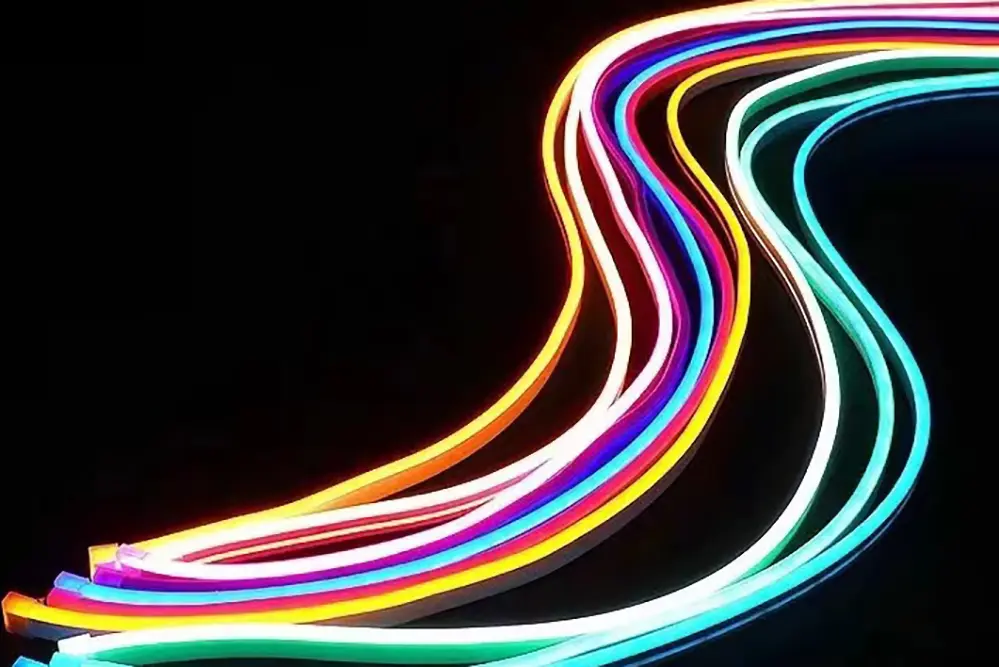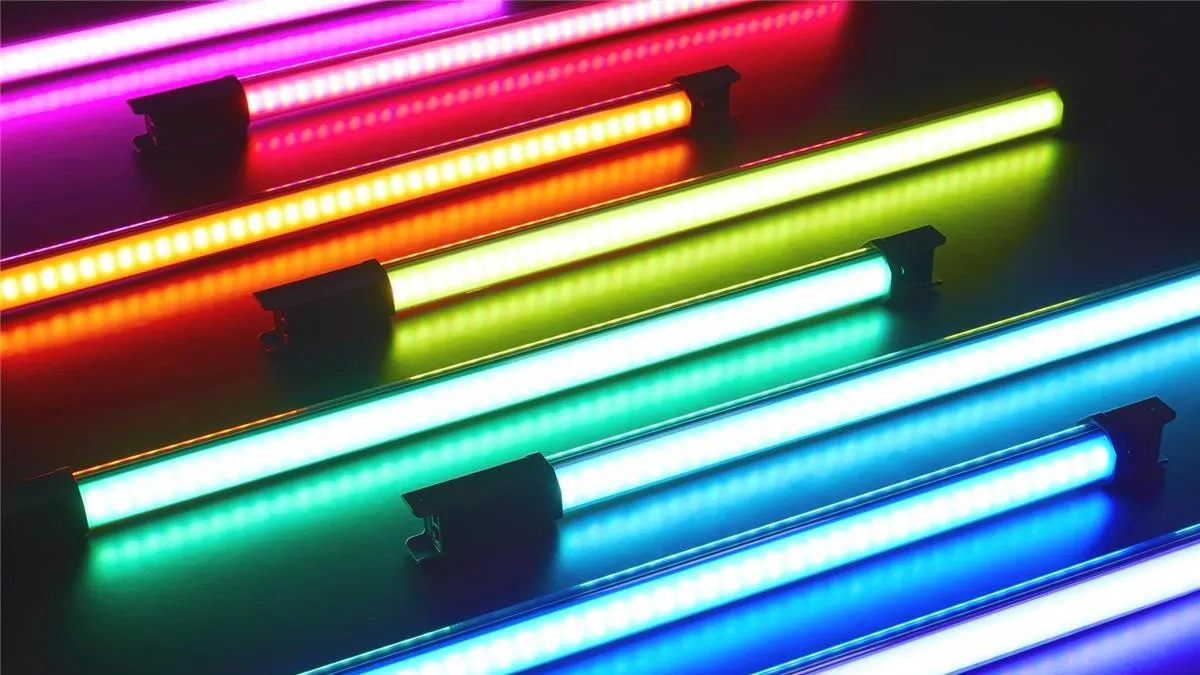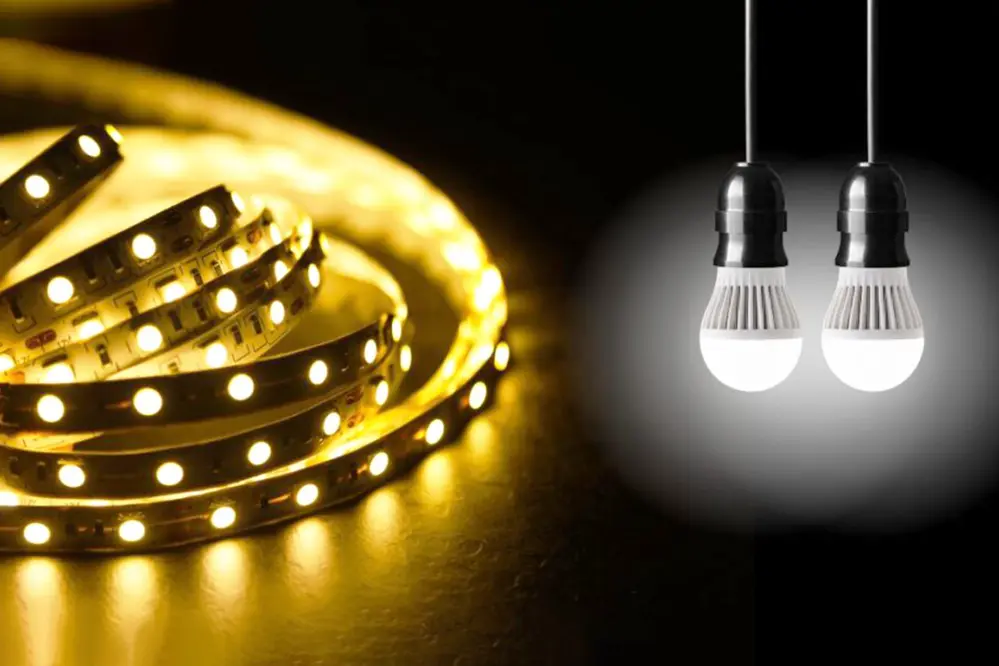In the dynamic realm of lighting technology, a crucial question often surfaces: in the battle of LED strip lights versus tube lights, which emerges as the superior choice? This query isn’t easily answered as it involves a spectrum of considerations, ranging from aesthetic appeal and energy efficiency to ease of installation and product longevity. These factors play pivotal roles in determining the ideal lighting solution.
I am Tom, a seasoned veteran in the LED industry since 2005. My extensive experience navigating through the complexities of LED technology has endowed me with valuable insights and expertise in a sector that’s constantly evolving; keeping pace means thoroughly understanding the subtleties and advantages of popular lighting options like LED strips and tube lights. My goal is to impart this knowledge, helping you stay informed and ahead in this ever-changing industry.
Embarking on this blog post, we aim to demystify the nuances of LED Strip vs Tube Lights. We’ll engage in an in-depth comparison covering various aspects such as design, energy efficiency, installation processes, and cost implications. Whether you are considering a modern upgrade for your office or contemplating a lighting revamp in your home, this guide is crafted to illuminate your decision-making process. Are you ready to explore this enlightening topic? Let’s dive in and shed light on the intricate details of LED strip and tube lights, commencing our enlightening journey into the world of LED lighting. Let’s get started right away!
Understanding LED Strip Lights: A Fusion of Elegance and Versatility
LED strip lights, a groundbreaking innovation in the lighting industry, present a harmonious blend of aesthetic appeal and practical functionality. Characterized by their slender profile, typically only a few millimeters in thickness, these lights offer a discreet yet potent lighting solution. When inactive, they are nearly invisible, but once illuminated, they provide an impressive intensity of light. It’s this blend of sleek design and adaptability that distinguishes LED strip lights in the lighting spectrum.
Notably versatile, LED strip lights can be tailored to specific lengths, catering to diverse requirements and spaces. They excel in accentuating architectural details or providing focused task lighting, such as under kitchen cabinets. Their flexibility extends to the spectrum of colors and temperatures available, enabling the creation of varied ambiances and atmospheres within any setting.
Energy efficiency is a significant attribute of LED strip lights. Their lower power consumption, compared to conventional lighting solutions, translates into long-term cost-effectiveness. Additionally, their minimal heat emission enhances safety, particularly in confined or delicate areas where traditional bulbs may present hazards. However, the installation of LED strip lights demands careful planning, from understanding power needs to ensuring a secure and proper setup.
Exploring LED Tube Lights: Contemporary and Efficient Lighting Solution
LED tube lights emerge as a contemporary substitute for traditional fluorescent tubes, melding the classic form with advanced LED technology. They are particularly acclaimed for their straightforward installation, making them a prime option for updating existing fluorescent setups in commercial and industrial environments.
These lights provide consistent and bright illumination, crucial in settings that demand clear visibility, such as offices, workshops, and retail areas. For emitting light across a 360-degree span, LED tube lights ensure an even distribution of light, minimizing shadows and glare.
One of the primary advantages of LED tube lights is their enhanced energy efficiency. They consume substantially less power than traditional fluorescent tubes, leading to noticeable reductions in energy costs and a decreased environmental impact. Additionally, their lack of hazardous materials like mercury renders them a safer and more eco-friendly choice.
Durability stands as another key feature of LED tube lights. Their robust construction makes them less susceptible to damage, and they typically outlast their fluorescent counterparts, reducing the frequency of replacements and maintenance. This durability, coupled with energy savings, positions LED tube lights as a cost-effective and long-lasting lighting solution.
Detailed Comparison: LED Strip vs Tube Lights
Diving into the specifics of LED strip and tube lights reveals key differences and similarities that are essential for an informed decision. Each has unique attributes that cater to diverse lighting requirements.
Design and Aesthetics
LED strip lights are celebrated for their contemporary design and remarkable flexibility. Their slim, bendable nature allows for creative integration in various settings – hidden under cabinets, tracing architectural lines, or in artistic installations. Their customizable length adds to their versatility, making them a go-to for modern design enthusiasts.
In contrast, LED tube lights offer a more traditional, linear aesthetic. Their uniform light distribution is ideal for environments needing consistent, bright illumination, such as offices and retail spaces. Their conventional design is a familiar sight, often preferred for its straightforward and functional appeal.
Energy Efficiency and Performance
Both LED strips and tube lights excel in energy efficiency. LED strips, with their smaller size, are particularly suited for low-power, targeted lighting like accentuation or mood setting. Tube lights, designed for broader illumination, are the choice for task-intensive areas, combining energy efficiency with high-quality light output.
Installation and Maintenance
Installation complexity varies between the two. LED strip lights require a more intricate setup involving precise wiring and power management. This allows for greater customization but might be daunting for the DIY novice.
LED tube lights, on the other hand, are more straightforward to install, often fitting directly into existing fluorescent fixtures, making them ideal for specific upgrades.
Cost-Effectiveness
Evaluating cost-effectiveness involves considering initial costs against long-term savings. LED strip lights, while more expensive upfront due to additional components, can be more cost-effective in the long run due to their energy efficiency and longevity.
Conversely, LED tube lights often present a lower initial investment, especially when retrofitting, and offer significant long-term savings in energy and maintenance.
Durability and Lifespan
Durability is a crucial aspect of both options. LED strip and tube lights are known for their extended lifespans, often exceeding tens of thousands of hours. The longevity of each, however, can be influenced by usage patterns, environmental conditions, and product quality.
Pros and Cons Analysis
Weighing the pros and cons of LED strip and tube lights is essential to determine the best fit for specific needs and contexts.
Vantagens das Fitas LED
LED strip lights shine with their extraordinary flexibility. They can be tailored to fit into various spaces, bent around curves, and offer a wide range of color options. Their modern design integrates well into contemporary spaces, making them ideal for both aesthetic and functional purposes. Their energy efficiency and low power consumption are significant advantages for cost-conscious consumers.
Downsides of LED Strip Lights
The main drawbacks of LED strip lights include their complex installation process and the need for additional components like power supplies and controllers. The durability of their adhesive backings can also be a concern, requiring extra mounting solutions in some environments.
Benefits of LED Tube Lights
LED tube lights are favored for their ease of installation, particularly in retrofitting projects. Their familiar design and robust build make them a reliable choice for traditional lighting needs. They are energy-efficient, with a longer lifespan than conventional fluorescent tubes, making them cost-effective in the long run.
Limitations of LED Tube Lights
The primary limitation of LED tube lights is their limited design flexibility. They are best suited for traditional, linear lighting applications and may not suit spaces requiring creative lighting solutions. Additionally, compatibility issues during retrofitting can be a concern, especially in older installations.
Usage Scenario or Application Field
When selecting between LED strips and tube lights, consider the specific usage scenario or application field. LED strip lights are ideal for decorative, accent, and mood lighting in homes, commercial spaces, and artistic settings. Their adaptability makes them suitable for unique lighting designs.
LED tube lights, conversely, are more suited for general illumination in commercial, industrial, and residential areas where consistent and reliable lighting is required. They are ideal for offices, classrooms, garages, and any space that benefits from uniform, bright light.
Selecting the Right Option for Your Needs
Making the right choice between LED strip and tube lights hinges on various factors that are unique to your environment and needs. It’s essential to consider a blend of aesthetic preferences, functional requirements, and practical installation considerations to ensure the chosen lighting solution aligns perfectly with your space.
For those seeking a lighting option that allows for creativity and customization, LED strip lights are unparalleled. They offer a modern and versatile solution, ideal for creating unique lighting designs. These lights are particularly suitable for spaces where aesthetics are a priority, such as in-home interiors, retail displays, or artistic installations. Their ability to be cut to size and their flexibility in color and brightness make them a top choice for bespoke lighting designs.
In contrast, LED tube lights are the go-to solution for traditional and straightforward lighting needs. They excel in environments where consistent and reliable illumination is key. Their ease of installation makes them an ideal choice for upgrading existing fluorescent setups in commercial buildings, industrial areas, and educational institutions. If your primary requirement is functional, uniform lighting with minimal installation complexity, LED tube lights are an excellent choice.
To further guide your decision, consider the following key points:
- Aesthetics: LED strip lights offer a sleek, contemporary look, while tube lights provide a more traditional, uniform appearance.
- Functionality: Strip lights are best for mood lighting and accents, whereas tube lights are suited for general illumination.
- Installation: Strip lights require more planning and additional components, making them a more involved project. Tube lights are easier to install, especially in retrofit situations.
- Cost-effectiveness: Consider both the initial investment and long-term savings. Strip lights may have a higher upfront cost but offer more significant energy savings over time.
- Durability and lifespan: Both options offer long-lasting performance, which can vary based on the product quality and usage conditions.
Ultimately, your choice between LED strips and tube lights should be informed by carefully assessing how each option meets your specific needs and enhances your space. Whether it’s the flexible creativity of strip lights or the straightforward functionality of tube lights, each has its unique strengths to consider.
Consultas e soluções técnicas
Obter informações de aplicações do mundo real e feedback dos utilizadores é inestimável para compreender os aspectos práticos das fitas e tubos de iluminação LED. Esta secção analisa as questões técnicas mais comuns e apresenta soluções baseadas em experiências reais de utilizadores e estudos de casos.
Consultas de instalação
Os estudos de caso revelam que, para quem está a atualizar as luminárias T8, as lâmpadas tubulares LED oferecem uma transição perfeita. Num recente projeto de modernização comercial, uma cadeia de lojas de retalho substituiu os seus antigos tubos fluorescentes T8 por tubos de iluminação LED. A transição foi simples, uma vez que os tubos LED encaixam diretamente nas luminárias existentes, reduzindo significativamente o tempo e o custo de instalação.
Em contrapartida, as fitas de LED requerem muitas vezes uma maior atenção aos pormenores durante a instalação, especialmente em termos de compatibilidade de tensão e interruptores de regulação da intensidade luminosa. Um estudo de caso que envolveu a renovação de uma casa moderna salientou a necessidade de cablagem adicional e a utilização de uma fonte de alimentação compatível para garantir que as fitas LED funcionavam corretamente com os interruptores reguladores de intensidade existentes. O projeto demonstrou a importância de um planeamento cuidadoso e da consideração dos sistemas eléctricos existentes ao instalar tiras de LED.
Perguntas sobre potência e desempenho
O consumo de energia e o desempenho são factores críticos na escolha da solução LED correta. Um estudo comparativo num ambiente de escritório mostrou que as fitas LED, que requerem 12 volts CC, eram mais eficientes em termos energéticos para iluminação de realce e de ambiente em comparação com os sistemas tradicionais de iluminação de calhas. O estudo também salientou a importância de garantir a compatibilidade com a infraestrutura de energia existente no edifício para otimizar o desempenho e a eficiência energética.
Noutro caso, um restaurante optou por lâmpadas tubulares LED para substituir as suas antigas lâmpadas fluorescentes. A mudança resultou numa redução significativa do consumo de energia, com os tubos LED a oferecerem o mesmo nível de luminosidade por uma fração do custo energético. Este caso sublinha o potencial de poupança de energia das lâmpadas tubulares LED em ambientes comerciais, onde a iluminação é um componente importante das despesas de energia.
Estes exemplos reais e avaliações de utilizadores fornecem informações práticas sobre os aspectos de instalação, potência e desempenho das tiras e tubos de iluminação LED, ajudando os potenciais utilizadores a tomar decisões informadas com base em casos de utilização reais.
Perguntas Frequentes
P: As fitas LED podem substituir as lâmpadas tubulares T8 em termos de luminosidade?
R: Embora as fitas de LED possam ser incrivelmente brilhantes, os tubos de luz T8 são geralmente mais brilhantes e mais adequados para ambientes que necessitam de iluminação intensa. No entanto, as fitas LED oferecem flexibilidade nos níveis de brilho e temperaturas de cor, tornando-as uma opção versátil para iluminação ambiente.
P: As fitas LED são mais eficientes em termos energéticos do que as lâmpadas tubulares?
R: Tanto as fitas LED como os tubos de luz são eficientes em termos energéticos, mas a eficiência pode variar consoante o produto específico. Geralmente, as fitas LED podem ter uma ligeira vantagem em termos de eficiência devido aos seus requisitos de energia mais baixos e ao comprimento personalizável.
P: Quanto tempo duram as fitas LED em comparação com as lâmpadas tubulares?
R: Ambos os tipos de lâmpadas têm uma longa duração, normalmente entre 20.000 e 50.000 horas. No entanto, a vida útil pode ser influenciada por factores como os padrões de utilização e a qualidade do produto.
P: É fácil instalar as fitas LED em comparação com as lâmpadas tubulares?
R: As luzes de fita LED requerem mais configuração, incluindo a instalação da cablagem e da fonte de alimentação. As lâmpadas tubulares, especialmente quando se trata de reequipar luminárias existentes, são geralmente mais simples e mais rápidas de instalar.
P: Posso utilizar os meus interruptores com regulação de fluxo luminoso existentes com as fitas de LED?
R: Depende do tipo de regulador de intensidade luminosa e das tiras de LED. Algumas tiras de LED são compatíveis com reguladores de intensidade luminosa normais, enquanto outras podem exigir um tipo específico, como uma fonte de alimentação regulável TRIAC.
P: As fitas LED são adequadas para utilização no exterior?
R: Sim, mas é crucial escolher tiras de LED que sejam especificamente classificadas para utilização no exterior, uma vez que serão à prova de água e concebidas para resistir aos elementos externos.
P: As lâmpadas tubulares LED podem ser utilizadas sem balastro?
R: Muitos tubos de iluminação LED modernos são concebidos para funcionar sem balastro, facilitando a instalação e reduzindo os requisitos de manutenção.
P: As fitas LED causam cansaço visual?
R: Geralmente, as fitas de iluminação LED não causam cansaço visual se forem instaladas corretamente. Proporcionam uma iluminação uniforme e sem cintilação, o que é mais fácil para os olhos, especialmente em locais onde o ambiente é importante.
P: Os tubos e as fitas de LED podem ser reciclados?
R: Sim, tanto os tubos como as fitas de LED podem ser reciclados. É importante verificar com os programas de reciclagem locais as diretrizes de eliminação específicas.
P: Existem opções de temperatura de cor para tiras de LED e tubos de luz?
R: Tanto as fitas LED como os tubos de luz oferecem uma gama de temperaturas de cor, permitindo-lhe escolher uma luz quente, neutra ou fria com base na sua preferência e na utilização prevista do espaço.
Conclusão: Como navegar na sua escolha de iluminação LED
Escolher a iluminação LED correta, quer se trate de fitas de LED ou de tubos de luz, implica considerar cuidadosamente o aspeto prático, a estética e a funcionalidade. É crucial compreender os pontos fortes e as limitações de cada opção e a forma como se alinham com as necessidades específicas do seu espaço. Este processo de tomada de decisão não é apenas uma questão de selecionar um produto, mas de encontrar uma solução de iluminação que complemente e melhore o ambiente em que é utilizada.
As fitas de iluminação LED, conhecidas pela sua versatilidade e personalização, são uma excelente escolha para quem procura dar um toque contemporâneo aos seus espaços. Ideais para criar designs de iluminação únicos, estas luzes são excelentes para melhorar a estética de uma área, ao mesmo tempo que são eficientes em termos energéticos e adaptáveis. Isto torna-as uma escolha preferida para projectos de iluminação inventivos e estéticos. Por outro lado, as lâmpadas tubulares LED oferecem uma abordagem mais tradicional à iluminação. São altamente eficientes e simples, o que os torna adequados para escritórios e áreas industriais onde a iluminação funcional e prática é essencial. A sua facilidade de instalação e o seu design familiar tornam-nas uma escolha sensata para várias aplicações.
Na sua exploração do panorama da iluminação LED, quer se trate da adaptabilidade das fitas LED ou da praticidade das lâmpadas tubulares, Unitop surge como um farol neste domínio. Como um dos principais fabricantes chineses de Fitas de LED e LED neon flexA Unitop está na vanguarda da inovação e da qualidade. O nosso compromisso com a excelência é evidente em todos os produtos que fabricamos, garantindo que recebe apenas o melhor da tecnologia LED. Se tiver mais perguntas ou requisitos específicos, não hesite em contactar-nos. Na Unitop, somos mais do que apenas um fabricante; somos o seu parceiro para iluminar o seu mundo com as melhores soluções LED. Contacte-nos hoje, e vamos iluminar o seu espaço com a experiência e o profissionalismo que só a Unitop pode oferecer.
Publicações relacionadas

Tom é agora o Gerente de Vendas de Unitop (China) Co., Limited. Ele tem estado no Iluminação LED indústria desde 2005. Ele é um especialista em vendas & marketing, e gestão de fábricas. Ele gosta de musculação, e é também um fã louco da Apple! Ele é um tipo trabalhador e adora aprender e experimentar coisas novas.
Email: tom@unitopledstrip.com WhatsApp: +86-18680307140








Deixe uma resposta
Quer juntar-se à discussão?Esteja à vontade para contribuir!